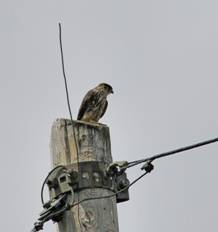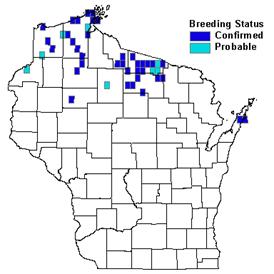

Status/Protection
- Global Rank: G5 Key to global and state ranks
- State Rank: S3B, S2N
- WBCI Priority: None
Population Information
The Federal BBS information can be obtained at http://www.mbr-pwrc.usgs.gov/bbs/bbs.html by clicking on Trend Estimates and selecting the species in question. All estimates are for time period (1966-2005).
- Federal Breeding Bird Survey: significant increase (limited data)
- Federal Breeding Bird Survey (WI): NA
- Federal Breeding Bird Survey (BCR 23): NA
- Federal Breeding Bird Survey (BCR 12): significant increase (limited data)
- WSO Checklist Project: significant increase (1983-2007)
Life History
- Breeding Habitat: White Pine, Inland Open Water, Open Bog, variety of habitats
- Nest: Platform (secondary cavity)
- Nesting Dates: Early June
- Foraging: Aerial pursuit (secondary hawking)
- Diet: Mostly small birds; also large insects (especially dragonflies), small rodents, bats and reptiles.
- Migrant Status: Short to medium distance migrant
- Habitat use during Migration: Open grasslands, semi-open forests, lakeshore & coastal areas.
- Arrival Dates: Early March to early May.
- Departure Dates: September to late November.
- Winter Range: Southern U.S. to northern South America.
- Winter Habitat: Open forest and grasslands.
Habitat Selection
The Merlin prefers open to semi-open areas, probably to facilitate hunting (Sodhi et al. 1993). Breeding habitat in the northern Great lakes region consists of mix coniferous-deciduous forest interspersed with numerous lakes and islands, bogs, along major rivers, prairie park-lands, forest steppes, and bare, burned over, open areas of glacier-scarred, metamorphic rock surrounded by mixed stands of white pine (Pinus strobus), spruce (Picea spp.), balsam fir (Abies balsamea) and scattered mature jack pines (Pinus banksiana) (Craighead and Craighead 1940, Doolittle 1992). In north-central Wisconsin using playback recordings, Solensky (1997) found that Merlins on lakes > 1 km squared with red (Pinus resinosa) and white pine stands more likely (95%) to respond than lakes < 1 km squared with a similar percentage of red and white pine component. In addition, lakes that were > 1 km squared and lacked or had few stands of red and white pine were less likely (5%) to have responses by Merlins. Also, Doolittle (1992) suggests that if a perimeter of the shoreline was convoluted and exceeded 161 km one is more likely to find breeding Merlins. In addition, Urban areas are sometimes used and use may be increasing (Oliphant and Haug 1985, Solensky 2001). Urban areas offer a diverse choice of suitable conifers for nesting with an abundant corvid population and adequate prey often associated with bird feeders.
Merlins usually use old corvid nests, especially those of American crows (Corvus brachyrnchos) and Common Ravens (Corvus corax) (Bent 1961, Doolittle 1992, Solensky 1997). Solensky (1997) reported several nesting characteristics in north-central Wisconsin: 1) the average number of overstory trees per 0.04 ha at the nest tree was 21, 2) mean canopy cover was 67%, 3) mean canopy height 18.7 m, mean nest tree height 20.2 m, mean nest height 16.9 m, 4) nest placed southeast or south, 5) one or more snags [usually white birch (Betula papyrifera)] used as observation perches within 30 m of nest tree. In addition, Doolittle (1992) found nest to be: 1) 35 m, on average, from dominate edge, usually water, 2) mean dbh 43.8 cm, 3) nest were located in the last suitable crotch nearest the tree’s top, 4) breeding territory may have 2 or more alternative nest. Individual breeding Merlin pairs may not use the same nest in subsequent years but other breeding pairs usually will (Doolittle 1992). Furthermore, Bent (1961) reported Merlins nesting in tree cavities in the eastern United States and Doolittle (1992) observed Merlins nesting in an abandoned bald eagle nest (Haliaeetus leucocephalus). Craighead and Craighead (1940) found Merlin nests to be separated by at least 3.2 km in northern Minnesota. Urban populations of Merlins in Wisconsin and Minnesota often use white spruce (Picea glauca) for nesting (Doolittle 1992).
Migration and winter habitat is similar to breeding habitat, (e.g. open forest and grasslands) (Sodhi et al. 1992). Often winters in cities throughout its range, where frequently perches on buildings, power poles, and tall trees (Oliphant and Haug1985, Servheen 1985).
Habitat Availability
Kumlein and Hollister (1903) reported Merlins breeding as far south as the city of Racine, Wisconsin. Doolittle (1992) reported the Merlins’ southern limits in Wisconsin to be Sawyer County. Several recent breeding territories have been identified in Rusk County (Chris Cold, pers. Comm.). Currently, Merlins nest in at least 16 northern counties of Wisconsin, including agricultural and urban areas (WBBA unpubl. data). Areas with dense aggregations of lakes or a large lake with convoluted shoreline and many islands may be ideal habitat (Doolittle 1992). Solensky (1997) reported a concentration of breeding Merlins on the Turtle-Flambeau Flowage and the town of Mercer ( Iron County), Minocqua area and Three Lakes Chain ( Oneida County), Star Lake area and the Eagle River Chain ( Vilas County). Merlins will nest in close proximity to human development as long as corvid nests are present. Furthermore, urban areas are seeing an increase in Merlin numbers, especially the areas with dense conifers and high populations of over wintering prey (Servheen 1985, Oliphant and Haug 1985, Solensky 2001).
Population Concerns
Loss of suitable habitat may be the major limiting factor affecting Merlin numbers, such as loss of nesting trees in woodlots and shelter belts, agricultural practices, and changes in wintering grounds (Sodhi et al. 1992). A decline in Merlin numbers was reported at Cedar Grove Ornithological Research Station ( Wisconsin) and Hawk Ridge ( Minnesota) in the early 1960s (Doolittle 1992), presumably because of high DDE levels in eggs and egg shell thinning (Sodhi et al. 1992). Although most Merlin populations are no longer effected by pesticide contamination and are reproducing well (Sodhi et al. 1992), some local populations may still be impacted (Becker and Sieg 1987). Migrating Merlin numbers started to increase significantly in the mid to late 1980s, especially at Cedar Grove (Doolittle 1992) and throughout northeastern North America (Titus and Fuller 1990). Between the years 1987 - 1991 there were 145 known areas with signs of breeding activity that occurred in the upper Midwest, with 112 occupied nests with 65 nests successful, producing a mean of 2.9 young/successful nest (Doolittle 1992). In north-central Wisconsin 56 breeding pairs were observed, of which 34 were successful with a mean of 3.6 young/successful nest (Solensky 1997). However, the Merlin is listed as a species of concern in the state of Wisconsin and is currently monitored by the Natural Heritage Inventory Program (NHI).
Recommended Management
Maintain mature conifer stands along large bodies of water and aggregated smaller lakes with at least 161 km of shoreline. An increase in corvid nesting in the upper Midwest and the ability to nest in urban areas may be the major factors for increase in Merlin numbers, and is not likely to change soon. Merlins have been reported to use artificial nest platforms in northern Wisconsin (Doolittle 1992). Songbirds are an important food source and management beneficial to songbirds also benefits Merlins.
Research Needs
As a Species of Special Concern in Wisconsin with little data, a statewide status assessment would seem important. Monitor breeding distribution changes and nest productivity in Wisconsin. Little is known about migration routes and stopover sites. Continue to monitor migration numbers to monitor the continental population. The effects of habitat loss and change in Central and South American wintering grounds may affect Wisconsin merlins. Periodically test for contaminants in eggs and egg thinning. The effects of predation on productivity and the source of predation are unknown.
Information Sources
- http://srfs.wr.usgs.gov/research/narms2.html
- http://web4.msue.msu.edu/mnfi/abstracts/zoology/Falco_columbarius.pdf
- http://www.mbr-pwrc.usgs.gov/bbs/htm96/map617/ra3570.html
References
- Becker, D.M., and C.H. Sieg. 1987. Eggshell quality and organochlorine residues in eggs of Merlins, Falco columbarius, in southeastern Montana. Canadian Field-Naturalist. 101:369-372.
- Bent, A.C. 1961. Life histories of North American birds of prey. Vol. 2. Dover Publications, Inc. New York.
- Craighead, J., and F. Craighead. 1940. Nesting Pigeon Hawks. The Wilson Bulletin. 52: 241-248.
- Doolittle, TC.J. 1992. Status of the eastern Taiga Merlin Falco c. columbarius in the upper midwest. M.S. The University of Wisconsin-Eau Claire. 131pp.
- Kumlien L. and N. Hollister. 1903. The birds of Wisconsin. Bulletin of the Wisconsin Natural History Society 3 1-143; reprinted with A.W. Schorger’s revisions, Wisconsin Society for Ornithology. 1951.
- Oliphant, L.W. and E. Haug. 1985. Productivity, population density and rate of increase of an expanding Merlin population. Raptor Research. 19:56-59.
- Servheen, C. 1985. Notes on wintering Merlins in western Montana. Raptor Research. 19:97-99
- Sieg, C.H. and D.M. Becker. 1992. Nest-site habitat selected by Merlins in southeastern Montana. The Condor. 92:688-694.
- Sodhi , N.S. , L.W. Oliphant, P.C. James, and I.G. Warkentin. 1993. Merlin (Falco columbarius). In The Birds of North America, No. 44 (A. Poole and F. Gill, Eds.). Philadelphia: Academy of Natural Sciences; Washington, D.C.: The American Ornithologists’ Union.
- Solensky, M.J. 1997. Distribution, productivity, and nest-site habitat of Taiga Merlins (Falco columbarius columbarius) in north-central Wisconsin. M.S. Thesis. University of Wisconsin-Eau Claire. 47 pp.
- Solensky, M.J. 2001. Merlin nest site reoccupancy in the Twin Cities and north-central Wisconsin. Unpublished report. UM-Raptor Center, St. Paul, Minnesota.
- Titus, K., and M.R. Fuller. 1990. Recent trends in counts of migrant hawks from northeastern North American. Journal of Wildlife Management. 54:463-470.
Contact Info
- Compiler: Dan Haskell, 5550 Mohawk Shores Dr. #4, Rhinelander, WI 54501, danhaskell@hotmail.com
- Editor: Bruce Bacon, 5291N State House Circle, Mercer, WI 54547. Bruce.Bacon@dnr.state.wi.us
